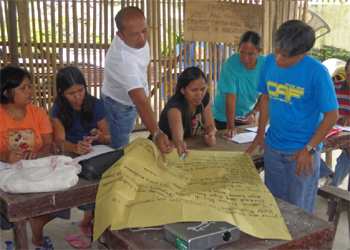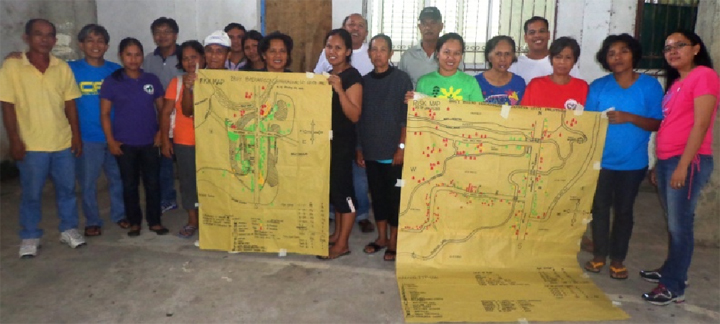 Story and Photos by Jonathan Sandigio | Program Officer | Heifer Central Philippines
Story and Photos by Jonathan Sandigio | Program Officer | Heifer Central Philippines
Self-Help Group (SHG) members and village officials from Bugho and Badiangon villages participated in a two-day community-based workshop on Disaster Risk Reduction (DRR) Assessment and Planning in Hinunangan, Southern Leyte, Philippines, January 29-30, 2013. These villages are among the nine community partners of the Food Secured and Sustainable Livelihood through Values-Based Development Approach for Small Farmers of Hinunangan, Southern Leyte development project. It is being implemented by South Pacific Integrated Area Development Foundation, Inc. (SPIADFI) with support from Heifer Philippines and DISOP Philippines.
The project plans to assist at least 837 families through gifts of livestock, trainings and other inputs. Through these gifts, partner families are expected to gain sustainable employment and income, and achieve food sufficiency while conserving and protecting the natural resources that support their livelihood activities.
Hinunangan is located on the eastern side of the Philippines facing the Pacific Ocean. Its proximity to the ocean makes it vulnerable to many hazards like storm surges, typhoons, tsunamis, landslides and floods. As such, disaster risk reduction is one of the major components of this project. Knowledge, skills and proper attitude toward preparedness and community resiliency are needed to protect the lives, livelihood and properties of the people. DRR also intends to protect the development inputs and gains of the community. DRR protects the resources received by the partner families from the donors.
“We have already attended many seminars and workshops related to disaster, but this one is different. This approach is better than what we had before. This will be very helpful for us in doing our duty in securing the lives and properties of our constituents,” said Reynaldo Cabug-os, Bugho village chief, who was very hesitant and skeptical when the workshop was first introduced to him. His hesitation and skepticism was replaced with enthusiasm and appreciation when he saw the outputs of the group. “I wish we had this activity a long time ago.”
“Through the use of a community-made risk map, we can easily identify exact location, accurate number of people that might be affected and the right place where people and their resources can be considered safe and secure during hazard events,” said Jose Delute, chief of the Barangay (village) Police of Badiangon. The Barangay Police play a vital role in ensuring the safety of everyone during hazard events in the community. They share in the responsibility of informing, providing warning, evacuating vulnerable people, assisting in rescue and retrieval operations and other roles noted in their DRR plan.
The participants conducted participatory community disaster risk assessment and analysis (PCDRAA) of their respective villages. Floods and typhoons were the hazards they prioritized to assess and analyze, as these are the most likely to affect their lives. They also studied the capacities and degrees of vulnerability of their own communities. PCDRAA outputs included identification of elements at risk during specific hazard events and the determination of the vulnerable sectors, resources and capacities of the community to cope with disaster, as well as their ability to bounce back from the negative effects of disasters.

Both villages have their own DRR organizations, and there is a need to improve the capacity of members and educate them to make the organizations more responsive and functional. All villages are mandated by law to create their own functional DRR Committees; this law also provides a corresponding budget for DRR-related initiatives and activities.
The Participatory Project Monitoring, Evaluation and Learning (PPMEL) aspect of DRR planning includes regularly updating data and information relative to DRR, adding other hazards being assessed, analyzed and included in the plan, and continuing to learn new trends and approaches to DRR.
Heifer Philippines’ Senior Program Manager Lyndell Tagle expressed Heifer’s commitment to help in building and developing disaster-resilient communities. He also mentioned the importance of building a network and linkages, especially with the local government units. “We cannot do it alone. We must connect our plans and initiatives with the proper authorities and other organizations. Let us also ask the support and cooperation of all members of the community,” Tagle said. He also requested that the group conduct activities with the purpose of disseminating and sharing DRR-related matters with everyone in the community.
Making the partner communities disaster-resilient is Heifer Philippines’ contribution to safeguarding the lives and properties of the people in the community. This includes the resources entrusted to Heifer by its donors and the development gains it has achieved so far.
Heifer Philippines and SPIADFI staff facilitated the workshop. Rico Locaba, Heifer Central Philippines’ regional program manager, served as main facilitator, while Lyndell Tagle, senior program manager for the field, also attended. Some representatives from other villages were present in order to prepare for a similar workshop that will be conducted in their villages in the future.
